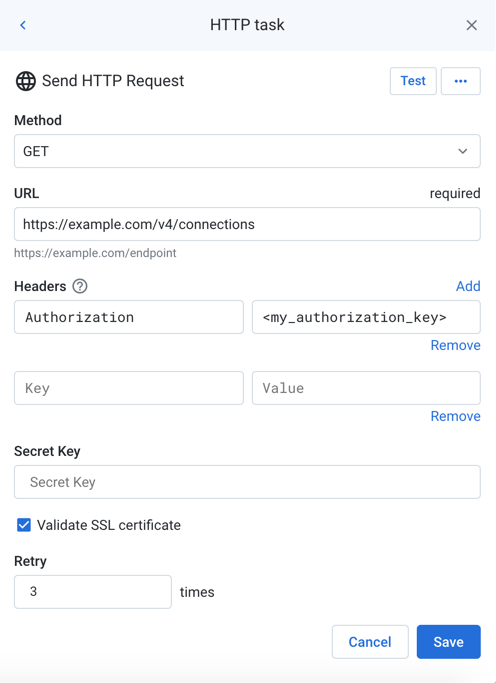Plan View for HTTP Tasks
Note
This feature may not be available in all product editions. For more information on available features, see Compare Editions.
In Plan View, you can create HTTP tasks to send request to endpoints before or after the execution of other tasks. These tasks are specified in the right context panel.

Figure: HTTP task
Fields:
Field | Description |
|---|---|
Method | Select the HTTP method to use to deliver the message. The appropriate method depends on the receiving application. Most use cases require the |
URL | URL where the HTTP request is received by the other application. |
Headers | Insert HTTP content headers as key-value pairs. For example, if your body is in JSON format, you should include the following header: key: Content-Type value: application/json Note You may be required to submit an authentication token as the value for the |
Body | ( {"text":"My text message to the receiving application."}Tip As part of the request body or header fields, you can insert metadata references to the plan definition, current run, tasks already executed in the run, and, column data and data sources. For more information on the available metadata, see Plan Metadata References. For examples of requests including metadata examples, see Create HTTP Task. |
Secret Key | (Optional) A secret key can be used to verify the request payload. This secret value must be inserted in this location, and it must be included as part of the code used to process the requests in the receiving application. Insert the secret value here as a string without quotes. For more information on how this secret key is used to generate a signature, SeeCreate HTTP Task. |
Validate SSL Certificate | When set to Note If you must send a request to an endpoint that has an expired/invalid certificate, you must disable SSL verification. |
Retry | If the returned status code is outside of the 200-299 range, then the HTTP task is considered to have failed. When this option is enabled, the request is retried. If the request fails, this value defined the number of times that the request should be retried. If this number of retries is reached without success, the task fails. |
For more information, see Create HTTP Task.